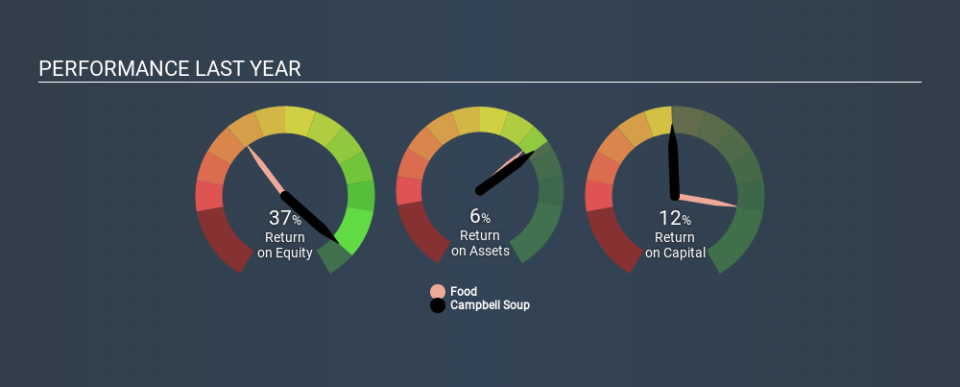Here's What Campbell Soup Company's (NYSE:CPB) ROCE Can Tell Us

Today we'll look at Campbell Soup Company (NYSE:CPB) and reflect on its potential as an investment. In particular, we'll consider its Return On Capital Employed (ROCE), as that can give us insight into how profitably the company is able to employ capital in its business.
Firstly, we'll go over how we calculate ROCE. Second, we'll look at its ROCE compared to similar companies. Finally, we'll look at how its current liabilities affect its ROCE.
What is Return On Capital Employed (ROCE)?
ROCE measures the amount of pre-tax profits a company can generate from the capital employed in its business. Generally speaking a higher ROCE is better. Ultimately, it is a useful but imperfect metric. Renowned investment researcher Michael Mauboussin has suggested that a high ROCE can indicate that 'one dollar invested in the company generates value of more than one dollar'.
So, How Do We Calculate ROCE?
Analysts use this formula to calculate return on capital employed:
Return on Capital Employed = Earnings Before Interest and Tax (EBIT) ÷ (Total Assets - Current Liabilities)
Or for Campbell Soup:
0.12 = US$1.1b ÷ (US$13b - US$3.4b) (Based on the trailing twelve months to October 2019.)
So, Campbell Soup has an ROCE of 12%.
Check out our latest analysis for Campbell Soup
Does Campbell Soup Have A Good ROCE?
ROCE can be useful when making comparisons, such as between similar companies. Campbell Soup's ROCE appears to be substantially greater than the 8.7% average in the Food industry. We would consider this a positive, as it suggests it is using capital more effectively than other similar companies. Regardless of where Campbell Soup sits next to its industry, its ROCE in absolute terms appears satisfactory, and this company could be worth a closer look.
Campbell Soup's current ROCE of 12% is lower than its ROCE in the past, which was 24%, 3 years ago. So investors might consider if it has had issues recently. You can click on the image below to see (in greater detail) how Campbell Soup's past growth compares to other companies.
It is important to remember that ROCE shows past performance, and is not necessarily predictive. Companies in cyclical industries can be difficult to understand using ROCE, as returns typically look high during boom times, and low during busts. This is because ROCE only looks at one year, instead of considering returns across a whole cycle. What happens in the future is pretty important for investors, so we have prepared a free report on analyst forecasts for Campbell Soup.
Do Campbell Soup's Current Liabilities Skew Its ROCE?
Current liabilities are short term bills and invoices that need to be paid in 12 months or less. Due to the way the ROCE equation works, having large bills due in the near term can make it look as though a company has less capital employed, and thus a higher ROCE than usual. To check the impact of this, we calculate if a company has high current liabilities relative to its total assets.
Campbell Soup has current liabilities of US$3.4b and total assets of US$13b. As a result, its current liabilities are equal to approximately 26% of its total assets. Low current liabilities are not boosting the ROCE too much.
The Bottom Line On Campbell Soup's ROCE
With that in mind, Campbell Soup's ROCE appears pretty good. There might be better investments than Campbell Soup out there, but you will have to work hard to find them . These promising businesses with rapidly growing earnings might be right up your alley.
For those who like to find winning investments this free list of growing companies with recent insider purchasing, could be just the ticket.
If you spot an error that warrants correction, please contact the editor at editorial-team@simplywallst.com. This article by Simply Wall St is general in nature. It does not constitute a recommendation to buy or sell any stock, and does not take account of your objectives, or your financial situation. Simply Wall St has no position in the stocks mentioned.
We aim to bring you long-term focused research analysis driven by fundamental data. Note that our analysis may not factor in the latest price-sensitive company announcements or qualitative material. Thank you for reading.

 Yahoo Finance
Yahoo Finance 
